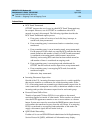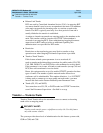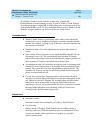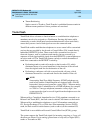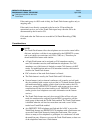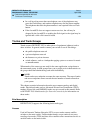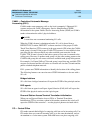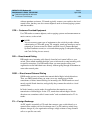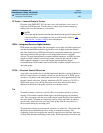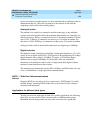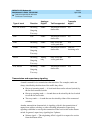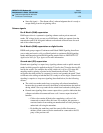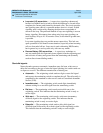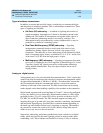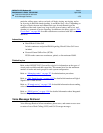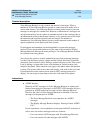
DEFINITY ECS Release 8.2
Administrator’s Guide
555-233-506
Issue 1
April 2000
Features and technical reference
1567Trunks and Trunk Groups
20
IP Trunks — Internet Protocol Trunks
IP trunks allow DEFINITY ECS to route voice calls and faxes over a local- or
wide-area TCP/IP network. Use IP trunks to reduce long-distance charges by
routing calls over the Internet or your intranet.
NOTE:
The origin and destination switches must both have the special hardware and
software needed to route telephone calls over IP networks. Refer to ‘‘
IP
trunk service’’ on page 1383 for more information.
ISDN — Integrated Services Digital Network
ISDN trunks are digital trunks that can integrate voice, data, and video signals and
provide the bandwidth needed for applications such as high-speed data transfer
and video conferencing. ISDN provides end-to-end digital connectivity and uses a
high-speed interface that provides service-independent access to switched
services. Through internationally accepted standard interfaces, an ISDN provides
circuit or packet-switched connectivity within a network and can link to other
ISDN-supported interfaces to provide national and international digital
communications. ISDN trunks can also efficiently combine multiple services on
one trunk group.
PCOL — Personal Central Office Line
A personal central office line is one dedicated trunk that links a group of phones to
the local central office or to another switch in a private network. A PCOL group
can have 1–16 phones, and each phone can have one or more appearances for the
personal central office line. You may administer a PCOL group as a CO, FX, or
WATS trunk group. Use a PCOL line when one or more users need a direct,
dedicated connection to the public network or to another switch.
Tie
Tie trunks connect a switch to a central office or to another switch in a private
network. These trunks transmit dialed digits with both outgoing and incoming
calls. Thus, incoming calls over a tie trunk can be routed directly to the extension
the caller dialed. Tie trunks are frequently used in private networks; in addition,
use tie trunks when you want a two-way trunk group with the convenience of
direct inward dialing for incoming calls.
Tie trunks that connect private network switches are “universal. “This means that
the trunks can be administered with a variety of translation encodes. The
originating switch can recognize any start dial signal (precise dial tone, wink start,
or delay dial) that the terminating switch sends. If the originating switch does not



